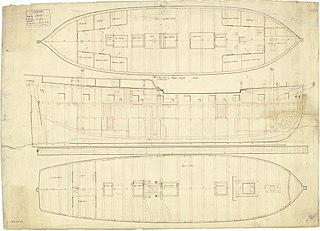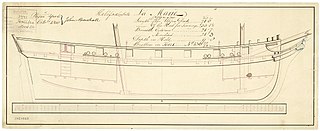Prince William was built in Newcastle in 1788. She then traded between England and the Baltic. The Royal Navy first hired her in 1797. His Majesty's hired armed ship Prince William served on two contracts, one during the French Revolutionary Wars and one during the Napoleonic Wars. The Admiralty returned her to her owners at the end of each contract.
HMS Scourge was the former merchant sloop Herald, launched in 1799, that the Admiralty purchased in 1803 for service as a convoy escort. The Admiralty had her laid up in 1805, and sold in 1816. Subsequent owners returned her to mercantile service and she sailed until 1835 when she was lost.

HMS Rattler was a 16-gun sloop of the Royal Navy. Launched in March 1783, she saw service in the Leeward Islands and Nova Scotia before being paid off in 1792 and sold to whaling company Samuel Enderby & Sons. She made two voyages as a whaler and two as a slave ship before she was condemned in the Americas as unseaworthy in 1802. She returned to service though, sailing as a whaler in the northern whale fishery, sailing out of Leith. She continued whaling until ice crushed her in June 1830.

HMS Hyaena was a 24-gun Porcupine-class post-ship of the Royal Navy launched in 1778. The French captured her in 1793, took her into service as Hyène, and then sold her. She became a privateer that the British captured in 1797. The Royal Navy took her back into service as Hyaena and she continued to serve until the Navy sold her in 1802. The shipowner Daniel Bennett purchased her and renamed her Recovery. She made seven voyages as a whaler in the British southern whale fishery and was broken up 1813.
Heart of Oak, of 300 tons (bm), was launched in South Carolina in 1762. She spent most of her career as a merchant vessel, though between 1777 and 1782 she served the Royal Navy as a hired armed ship. She was last listed in 1789.
Many vessels have borne the name Experiment:
HMS Cockatrice was the fourth of the Alert-class British Royal Navy cutters. She was launched in 1781 and had an uneventful career until the Navy sold her in 1802. Private interests purchased her, lengthened her, and changed her rig to that of a brig. They hired her out to the Navy and she was in service as a hired armed brig from 1806 to 1808. She then returned to mercantile service until she was condemned at Lisbon in May 1816 as not worth repairing.
Rolla was a French brig launched in 1801 or 1803, that came into British hands in 1804. She became a privateer and then a slave ship in the triangular trade in enslaved people, but before she was able to embark any captives the French Navy captured her. The British Royal Navy recaptured her and took her into service as HMS Rolla. She served in Sir Home Riggs Popham's attack on Buenos Aires. She returned to Britain in December 1807 and was laid up. The Admiralty sold her in 1810 and she became a merchant vessel. She was last listed in 1826, and may have been lost on the coast of Brazil in 1825.
HMS Pilote was a cutter launched for the French Navy at Dunkirk in 1778. The British Royal Navy captured her in 1779 and took her into service under her existing name. It sold her in 1799.
HMS Duguay-Trouin was an 18-gun French privateer sloop launched in 1779 at Le Havre. Surprise captured her in 1780 and the British Royal Navy took her into service under her existing name. It sold Duguay-Trouin on 30 October 1783. She then became the West Indiaman Christopher. She captured several French merchant vessels. Later she became a Liverpool-based slave ship, making five voyages in the triangular trade in enslaved people. She was lost at Charleston in September 1804 in a hurricane.
HMS Meteor was originally the merchant ship Lady Cathcart launched at Leith in 1794. The Royal Navy purchased her in 1797, used her as a gun-brig escorting convoys in the North Sea, and sold her in 1802. She then returned to mercantile service under her original name and continued to trade along the British coast. She was last listed in 1822.
HMS Mastiff was launched at Hull in 1790, as Herald. From there she traded with the Baltic. The British Royal Navy purchased her in 1797, had her fitted at Leith, and named her GB №35, and then Mastiff. She served as a convoy escort in the North Sea until she wrecked in 1800.
HMS Jane was the North Carolina ship General Nash. In September–October 1780 General Nash operated as a privateer and captured several British merchant vessels. The British captured General Nash when they took St Eustatius on 14 February 1781. The Royal Navy took General Nash into service as HMS Jane. In 1782 the American privateer Tartar captured Jane.
Blenheim may have been launched in 1776 in Philadelphia as Britannia. By 1777 she was the Massachusetts-based privateer American Tartar and had taken several prizes. She had also participated in an inconclusive single-ship action with a British merchantman. The British Royal Navy captured American Tartar late in 1777 and she became HMS Hinchinbrook. The Royal Navy sold her in 1783 and she became the West Indiaman Blenheim. In 1785-86 she became a Greenland whaler and she continued in that trade until two French frigates captured and burnt her in 1806.
The Royal Navy purchased HMS Barracouta on the stocks in 1782. After she had served for almost ten years patrolling against smugglers, the Navy sold her in 1792. She became the privateer Thought, which had a successful cruize, capturing several prizes including a French privateer, but then was herself captured in September 1793. She served the French Navy under the names Pensée, Montagne, Pensée, and Vedette, until the British recaptured her in 1800 and renamed her HMS Vidette. The Royal Navy sold her in 1802.
Magdalen was launched in 1802 at Mehil, Fife. From 1804 to 1805, she served on convoy duty in the North Sea for the British Royal Navy as a hired armed ship. She then returned to mercantile service and continued to sail for over 45 years, going as far as Malta and Quebec, though mostly sailing along Britain's coasts. She was last listed in Lloyd's Register (LR) in 1853.
Good Design was launched in Shields in 1793. She became a Newcastle-based transport. Between 1797 and 1802 she served the British Royal Navy as a hired armed ship, convoying vessels in the North Sea and transporting troops. Her crew qualified for a clasp to the Naval General Service Medal for her service in the 1801 Egyptian campaign. She returned to mercantile service and apparently was lost in 1805.

HMS Halifax was the French privateer brig Marie that the Royal Navy captured in November 1797 and took into service. The Navy sold her in 1801 and she became the merchantman Halifax. She sailed between Portsmouth and Newfoundland and was last listed in 1808.
HMS Pouncer was the mercantile David, launched in 1785 at Leith, that the Admiralty purchased and armed in 1797 as GB No.38. David originally sailed to the Baltic and then to the Mediterranean. From 1793 or so till her sale to the Admiralty she sailed as a transport under contract to the Transport Board. The Navy renamed GB No.38 HMS Pouncer, and she was the only naval vessel ever to bear that name. The Navy sold Pouncer in 1802 following the Peace of Amiens. She then returned to mercantile service as the West Indiaman David. Under several masters and owners she traded more widely. In 1816 she sank, but was recovered.
Mentor was launched in 1792 at Wemyss. With the out break of war with France in early 1793, the Royal Navy needed smaller vessels to protect convoys from privateers. The Navy employed Mentor as a hired armed vessel, releasing her from her contract at the end of 1801 after the signing of the Treaty of Amiens. She then returned to mercantile service, sailing first to Hamburg and then Oporto. She became a coaster on England's east coast, or a Baltic trader. She was last listed in 1832.


